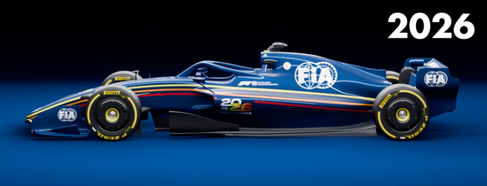2026 FIA FORMULA 1 REGULATIONS HUB The new Formula 1 car
- Sport Time

- Apr 14
- 3 min read
A New Era of Competition: FIA showcases future-focused Formula 1 regulations for 2026 and beyond

- ‘Nimble car’ concept at the heart of 2026 Technical Regulations targets improved raceability and closer racing. The new Formula 1 car.
- The 'Agile car' concept, which is at the heart of the 2026 Technical Regulations, aims for better and closer races.
2026'daki Formula 1 araçları şu andaki Formula 1 araçalarından 30 kg daha hafif olacak ve yol tutuşu daha iyi olacak.
The power unit has been redesigned it has about %300 more battery power. It is based on teh most efficient engines in the world, with equal Decoupling between Internal Combustion and Electric power. The new Formula 1 car.
Another innavation is active aerodynamics, which meets the energy management requirements of the new power units.
Increased overtaking opportunities through new Manual Override Mode granting more electrical power deployment for the following car.
Record number of six power unit manufacturers with Ferrari, Mercedes, Alpine, Honda, Audi and Red Bull Ford Powertrains committed to F1 from 2026.
2026 cars to run on 100% sustainable fuel.
The most important thing, safety, has been improved after many strong structures and more demanding tests.
After the announcement of the outlines of the new regulations, which were developed in consultation with the FIA Formula 1 Technical Working Groups and formulated in cooperation with Formula 1, the sport's 10 teams, OEMs and power unit manufacturers, The 2026 regulations are now set to be officially ratified by the World Motor Sport Council on June 28.

Power Unit
First published in August 2022, the power unit regulations provide for a major leap forward. Building on the foundations of the world’s most efficient hybrid engine currently used in Formula 1, the 2026 power unit delivers even more power than the current PUs. While the power derived from the ICE element drops from 550-560kw to 400kw, the battery element increases massively, from 120kw to 350kw – an almost 300% increase in electric power. Performance is therefore maintained, while sustainability is increased even further.

Chassis
Designed to be smaller and lighter than the current generation of cars, the dimensions of the car have been altered to adhere to the ‘nimble car’ concept at the heart of the new rules. The wheelbase drops from a maximum of 3600mm to 3400mm, while the width has been reduced from 2000mm to 1900mm. The maximum floor width will be reduced by 150mm.

Aerodynamics
The 2026 cars will also benefit from all-new Active Aerodynamics systems. The system, involving movable front and rear wings, will result in greater cornering speeds with standard Z-Mode deployed. On straights drivers will be able to switch to X-Mode a low-drag configuration designed to maximise straight-line speed.

Safety
The FIA’s rigorous pursuit of safety is upheld in the 2026 Formula 1 regulations.
Revised front impact regulations introduce a two-stage structure to avoid incidents in recent years where the front impact structure (FIS) has broken-off close to the survival cell after an initial impact, leaving the car unprotected for a subsequent impact.
Side intrusion protection has been increased. The new specification gives improved intrusion protection around the cockpit and more than doubles the protection given by the side of the fuel cell. Additionally, the improved intrusion protection will be achieved without adding weight.
Roll hoop loads have been increased from 16G to 20G in line with other single seater formulas and test loads increased from 141kN to 167kN.

Rear wing endplate lights will be homologated and significantly more visible/bright than current ones. Lateral safety lights will be introduced to identify the ERS status of a car stopped across the track.
The GPS antenna is being repositioned to improve sensitivity and to allow for future developments in active safety.
Sustainalibity
From 2026 Formula 1 power units will run on fully sustainable fuel, underscoring the commitment to environmentally responsible racing and setting a new standard for motorsport.
This fuel will be ‘drop-in’, meaning it can be used in almost any ICE-powered vehicle, offering a potentially game-changing solution to greenhouse gasses in the transportation sector. By 2030 there will be 1.2bn ICE cars on the road worldwide and the fuel developed for Formula 1 could be used to reduce emissions on an industrial scale.
Sustainability will be enhanced through greater use of electric power in the 2026 power units and a shift to towards a 50% electrical and 50% thermal power distribution.

The 2026 regulations are in line with the FIA objective of reaching Net Zero carbon by 2030.
Note
The 2026 regulations are now set to be officially ratified by the World Motor Sport Council on June 28













Comments